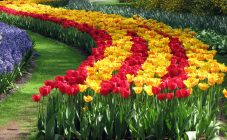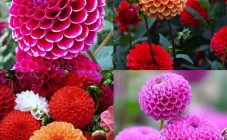Content:
Irises are very beautiful and unusual plants, they got their name in honor of the goddess of the rainbow. Iris is distinguished by a huge variety of shapes and colors. This article will present the characteristics of the bearded iris, as well as the specifics of growing this plant.
Bearded iris
This type of plant is the most favorite and common among flower growers. Other names for the plant are cockerels or killer whales. Bearded irises are divided into subspecies according to flower size:
- standard dwarf (40 cm);
- miniature dwarf;
- standard medium-sized (40-70 cm)
- small-flowered medium-sized;
- medium-sized binders;
- high (above 70 cm).
This culture is liked by gardeners for the variety of colors.
Bearded iris: planting and care in the open field
How to plant bearded irises correctly? The main thing is to choose the right time for landing in the ground. The optimal time is spring or autumn.
The culture is planted only with rhizomes, they are not sown with seeds, because varietal characteristics are lost. A lush flowering plant is achieved by replanting every 3-4 years.
Preparation of soil and planting material
This crop prefers well-drained non-acidic soils, can grow even on slightly rocky soil. On acidic soils, the plant will grow only deciduous mass. In clayey soil, water will linger, and iris do not like this. Gardeners have learned to adapt any soil for irises:
- dense and heavy soil is diluted with coarse grained sand, water will no longer linger;
- sand and peat are introduced into clay soil;
- acidic is neutralized with lime.
The site for the culture must be carefully dug up, all weeds must be removed. It is recommended to apply manure, necessarily rotted, to a depth of 25 cm, without mixing with the ground.
Delenka (unit of iris) must have one formed root, leaves fanned at least 15 cm. The rhizome must be:
- elastic;
- without decay;
- dense.
At the root, the rudiments of future sprouts (yellowish-green tubercles) must be visible. The central leaf should be dense, green, not dry. The side leaves may be slightly dry. Too large planting material may indicate plants overfed with fertilizers, which are more susceptible to diseases.
The winter hardiness of the iris depends on the variety, but in almost all varieties it is high. The correct choice of a plant variety, zoned specifically for the area where it will grow, will allow to successfully grow a culture.
How to plant bearded irises
The crop prefers sunny areas that shade slightly in the afternoon. In the shade, irises bloom very poorly. The place for killer whales should be protected from the winds. Planting a plant on a slope on the south side will be successful.
When growing irises, you need to remember a few recommendations:
- the rhizome is best placed on the south side, and the leaves on the north;
- you cannot plant the rhizome deeply.
You need to dig a shallow hole under the root, make a mound in the center, put the rhizome there, and distribute the roots along the sides.Cover the lateral roots with soil, and the rhizome with sand with a layer of 2 cm. Some gardeners add ash and even gravel.
The recommended distance between tall species is about 50 cm, and between dwarfs about 30 cm.
There are three schemes for planting irises:
- "Chess": the irises are placed towards each other, keeping a distance of 50 cm between them;
- "Catch-up": the culture is followed by leaves, the distance between plants is 40 cm;
- "Round dance": there is a distance of 30 cm between the irises, with this scheme, the plants should be planted away from the edge of the flower bed.
When to divide a plant
It is necessary to divide the culture in the summer, after the end of flowering. Different varieties have different flowering times, so planting times will depend on the variety.
After flowering, the culture begins an active growth of the root system, which means that the plant will have a high survival rate during this period. Three weeks after flowering, you can start dividing the bush.
You can plant the plant until the end of August, with the exception of the southern part of Russia, where you can divide it in September. In central Russia, the division should not be delayed, the plant simply will not have time to take root before winter and will die.
It is necessary to separate the rhizome with a disinfected knife (potassium permanganate solution: 15 g per 10 liters of water), before a new incision, the knife is disinfected again. Sections of the cut also need to be treated with a solution of potassium permanganate. New roots are deepened into the sand by 3 cm.
Iris transplant in summer
Planting in open ground will be successful if you carefully study the characteristics of the culture. July is considered the ideal month for replanting and dividing the plant. In the heat, the irises go into hibernation, which is why the second summer month is suitable for transplanting.
Further care
Planting and further caring for a bearded iris is only at first glance an easy task, in fact, you need to take care of it very carefully.
The care of iris includes: weeding, watering, loosening, feeding, pruning, preparation for winter.
Iris is a fairly drought-resistant culture. They accumulate moisture in the roots. Excessive moisture will lead to the termination of flowering, in the worst case, to rotting of the rhizome. Watering irises should be done only when the soil becomes completely dry. Watering is necessary in the evening, avoiding water getting on the leaves and flowers.
Top dressing of the culture is carried out three times per season. In the spring, it is very important to apply nitrogen (nitrate) fertilizers, which will start to stimulate plant growth. It is not necessary to apply phosphorus fertilizers during this period. In the summer, it is required to make fertilizing in the ammonium form, as well as phosphorus.
In the fall, they are fed with phosphorus and potassium, which contribute to the successful wintering of the plant.
Cropping is carried out in August. The dried outer leaves are torn off, and the inner ones are slightly trimmed. This will prevent the development of diseases on dry leaves, as well as maintain a pleasant appearance of the plant.
Dwarf and medium-sized irises do not need to be covered for the winter, tall ones should be covered. It is recommended to sprinkle dry leaves over the irises. Experienced gardeners recommend oak foliage, then put spruce branches, and cover all this with foil.
Among all the variety of irises, many gardeners choose bearded irises for planting on their site, for their unusual beauty. It is only necessary to grow such a plant in the open field, it will not work in a pot, because the roots need a lot of space.















